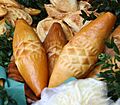List of Polish cheeses facts for kids
Poland has a long and tasty history of making cheese! People in Poland were already making cheese way back in 5500 BC. That's over 7,500 years ago! They made a cheese similar to mozzarella in a region called Kujawy. Today, Poland is one of the world's biggest cheese producers. It ranks 6th globally! There are hundreds of different Polish cheeses. Some of these special cheeses are even protected by European Union laws.
Contents
A World of Polish Cheeses
Poland is home to many unique and delicious cheeses. Each one has its own special story and flavor. Let's explore some of the most popular and interesting ones.
Famous Polish Cheeses
Bryndza
Bryndza is a soft cheese made from sheep milk. It is popular in both Poland and Slovakia. The way it's made can be a little different depending on where you are. A special Polish version, called Bryndza Podhalańska, comes from the Podhale region. This cheese is so special that the European Union protects its name. This means only cheese made in that specific region, following certain rules, can be called Bryndza Podhalańska.
Bundz
Bundz is another cheese traditionally made from sheep milk. You'll often find it in the Podhale region, just like Bryndza Podhalańska. It's a fresh, soft cheese that's a favorite in the Polish mountains.
Farmer Cheese (Twaróg)
In Poland, Farmer cheese is known as Twaróg or ser biały (which means "white cheese"). It's a fresh, soft cheese that looks a bit like cottage cheese. It's often pressed into a loaf or a wedge shape. Twaróg is very popular for breakfast, in sandwiches, or used in baking.
Gołka
Gołka is a cheese that looks and tastes a lot like oscypek. However, Gołka is made from milk from cattle, not sheep. It's often found in the Silesian Voivodeship region.
Hauskyjza
Hauskyjza is a very unique Polish food. It's made from cottage cheese, caraway seeds, and other ingredients. These are mixed together and left for a few days. This process gives the cheese a strong, sharp flavor and a sticky texture. After that, it's warmed up and fried. It's popular in regions like Greater Poland, Pomerania, Kuyavia, and Silesia.
Koryciński Cheese
Koryciński cheese is a hard, yellow cheese made from cow's milk. It gets its name from the town of Korycin in eastern Poland's Podlaskie Voivodeship. This cheese is known for its firm texture and rich flavor.
Królewski Cheese
"Królewski" means "Royal cheese" in Polish. This cheese is similar to the famous Swiss Emmental cheese. It has a mild, nutty taste and is often recognized by its holes. It's produced in northwestern Mazovia.
Morski Cheese
Morski is a mild, semi-soft cheese made from pasteurized cow's milk. It melts very well, which makes it a great choice for cooking. It's also often enjoyed simply as a table cheese.
Oscypek
Oscypek is one of Poland's most famous cheeses! It's a smoked cheese made from sheep milk. It's made only in the Tatra Mountains region of Poland. Oscypek often has beautiful decorative shapes. There's also a smaller version called redykołka, which is sometimes called the "younger sister" of Oscypek.
Redykołka
Redykołka is produced in the Podhale region, just like Oscypek. It's often called the "younger sister" of Oscypek, and sometimes people get them mixed up. Redykołka is usually made in fun shapes like animals, hearts, or decorative wreaths.
Rokpol
Rokpol is a Polish blue cheese. It's similar to Danish blue cheeses but is made with cow's milk. The name "Rokpol" sounds a bit like "Roquefort," which is another famous blue cheese. Rokpol has a strong, tangy flavor.
Tylżycki Cheese
Tylżycki is a yellow, semi-hard cheese made from cow's milk. It's a type of Tilsit cheese, which originally came from East Prussia. It's produced in the Masuria region of Poland.
Other Polish Cheeses
- Bałtycki: A Polish brand of cheese.
- Bursztyn: A mature cheese that tastes similar to Gruyere.
- Edamski: A cheese based on the Dutch Edammer, made in Masuria.
- Gryficki: Production of this cheese started in 1973 in the Gryfice Dairy.
- Kortowski: Another Polish cheese.
- Lechicki: Also known as Brochocki cheese, named after the farmer who first made it.
- Liliput: A cow's milk cheese from Greater Poland.
- Łowicki: A Polish cheese.
- Lubuski: A Polish cheese.
- Mazurski: A brand of cheese.
- Przeworski: A ripening cheese made from cow's milk with mint and marjoram. It has a spicy taste and herb aroma. It's named after the town of Przeworsk.
- Radamer: A cow's milk cheese with influences from Dutch and Swiss cheeses, from Polesia.
- Słupski chłopczyk: A Camembert-type cheese. It was made before World War II, brought back in 2007, but stopped production in 2013.
- Zamojski: A Polish cheese.
- Zgorzelecki: A semi-hard, yellow cheese made from cows' milk.
Images for kids
See also









